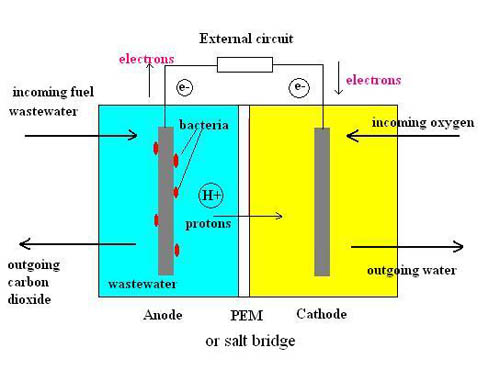Team:FHS Frederick MD/Microbial Fuel Cells
From 2014hs.igem.org
(Difference between revisions)
(→Microbial Fuel Cells: Increased image size) |
(Added footer) |
||
| Line 1: | Line 1: | ||
{{:Team:FHS_Frederick_MD/Header}} | {{:Team:FHS_Frederick_MD/Header}} | ||
| - | |||
=Microbial Fuel Cells= | =Microbial Fuel Cells= | ||
[[File:FuelCell.jpg|right|500px]] A microbial fuel cell is a device that converts the chemical reactions of bacteria into electricity. Within the fuel cell certain bacteria under anaerobic conditions will remove the electrons from organic matter and transfer them to an anode, which will then transfer the electrons through a circuit to a cathode. The current and voltage produced by this process is what creates the electricity required to power certain objects such as a light bulb. | [[File:FuelCell.jpg|right|500px]] A microbial fuel cell is a device that converts the chemical reactions of bacteria into electricity. Within the fuel cell certain bacteria under anaerobic conditions will remove the electrons from organic matter and transfer them to an anode, which will then transfer the electrons through a circuit to a cathode. The current and voltage produced by this process is what creates the electricity required to power certain objects such as a light bulb. | ||
The bacteria that we are currently creating is meant to optimize the microbial fuel cell's potential, as bacteria that will glow under anaerobic conditions will reveal any weaknesses in the fuel cell, structural or otherwise, which can then be assessed and dealt with. | The bacteria that we are currently creating is meant to optimize the microbial fuel cell's potential, as bacteria that will glow under anaerobic conditions will reveal any weaknesses in the fuel cell, structural or otherwise, which can then be assessed and dealt with. | ||
| + | {{:Team:FHS_Frederick_MD/Footer}} | ||
Latest revision as of 01:27, 21 June 2014
Microbial Fuel Cells
A microbial fuel cell is a device that converts the chemical reactions of bacteria into electricity. Within the fuel cell certain bacteria under anaerobic conditions will remove the electrons from organic matter and transfer them to an anode, which will then transfer the electrons through a circuit to a cathode. The current and voltage produced by this process is what creates the electricity required to power certain objects such as a light bulb.The bacteria that we are currently creating is meant to optimize the microbial fuel cell's potential, as bacteria that will glow under anaerobic conditions will reveal any weaknesses in the fuel cell, structural or otherwise, which can then be assessed and dealt with.
 "
"


